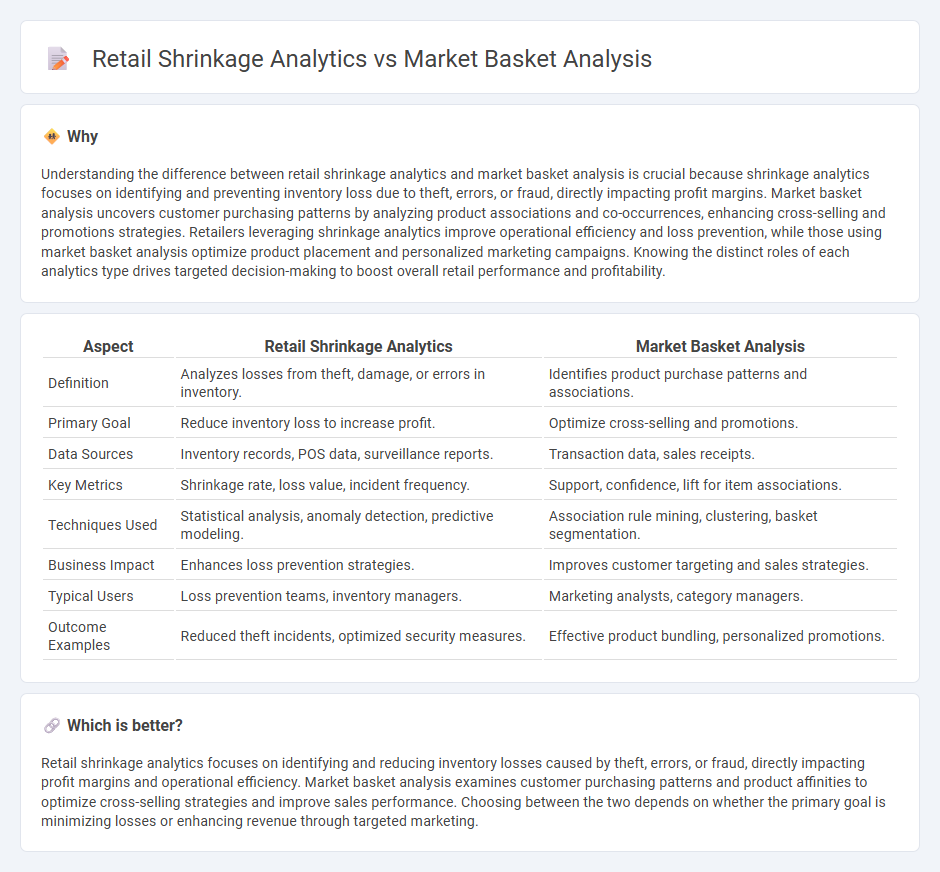
Retail shrinkage analytics focuses on identifying and reducing losses due to theft, errors, and fraud by analyzing transaction data and inventory discrepancies. Market basket analysis examines customer purchase patterns to reveal product affinities and optimize cross-selling opportunities, enhancing sales and customer experience. Discover how combining these analytics can drive profitability and operational efficiency in retail.
Why it is important
Understanding the difference between retail shrinkage analytics and market basket analysis is crucial because shrinkage analytics focuses on identifying and preventing inventory loss due to theft, errors, or fraud, directly impacting profit margins. Market basket analysis uncovers customer purchasing patterns by analyzing product associations and co-occurrences, enhancing cross-selling and promotions strategies. Retailers leveraging shrinkage analytics improve operational efficiency and loss prevention, while those using market basket analysis optimize product placement and personalized marketing campaigns. Knowing the distinct roles of each analytics type drives targeted decision-making to boost overall retail performance and profitability.
Comparison Table
| Aspect | Retail Shrinkage Analytics | Market Basket Analysis |
|---|---|---|
| Definition | Analyzes losses from theft, damage, or errors in inventory. | Identifies product purchase patterns and associations. |
| Primary Goal | Reduce inventory loss to increase profit. | Optimize cross-selling and promotions. |
| Data Sources | Inventory records, POS data, surveillance reports. | Transaction data, sales receipts. |
| Key Metrics | Shrinkage rate, loss value, incident frequency. | Support, confidence, lift for item associations. |
| Techniques Used | Statistical analysis, anomaly detection, predictive modeling. | Association rule mining, clustering, basket segmentation. |
| Business Impact | Enhances loss prevention strategies. | Improves customer targeting and sales strategies. |
| Typical Users | Loss prevention teams, inventory managers. | Marketing analysts, category managers. |
| Outcome Examples | Reduced theft incidents, optimized security measures. | Effective product bundling, personalized promotions. |
Which is better?
Retail shrinkage analytics focuses on identifying and reducing inventory losses caused by theft, errors, or fraud, directly impacting profit margins and operational efficiency. Market basket analysis examines customer purchasing patterns and product affinities to optimize cross-selling strategies and improve sales performance. Choosing between the two depends on whether the primary goal is minimizing losses or enhancing revenue through targeted marketing.
Connection
Retail shrinkage analytics identifies patterns and causes of inventory loss, which directly impacts sales performance analyzed through market basket analysis. By integrating shrinkage data with customer purchase behavior, retailers can detect suspicious transaction trends and product theft linked to specific item groupings. This synergy enhances decision-making for loss prevention strategies and optimizes product placement to maximize profitability.
Key Terms
**Market Basket Analysis:**
Market Basket Analysis leverages transaction data to identify product associations and purchasing patterns, enabling retailers to optimize product placement, cross-selling strategies, and inventory management. By analyzing item co-occurrence in customer baskets, it helps increase sales through targeted promotions and personalized recommendations. Explore more about how Market Basket Analysis drives retail growth and customer engagement strategies.
Association Rules
Market basket analysis leverages Association Rules to identify product purchase patterns by analyzing transactional data, enabling retailers to optimize product placement and cross-selling strategies. Retail shrinkage analytics applies similar Association Rules to detect unusual item combinations that signal theft or inventory discrepancies, enhancing loss prevention efforts. Explore how integrating Association Rules in both domains drives data-driven decision-making and operational efficiency.
Cross-Selling
Market basket analysis identifies product combinations frequently purchased together, enabling retailers to optimize cross-selling strategies by suggesting complementary items at checkout. Retail shrinkage analytics focuses on loss prevention through detecting theft, errors, and fraud, indirectly supporting cross-selling by maintaining inventory accuracy and product availability. Explore how integrating both approaches can maximize cross-selling opportunities and reduce losses in retail environments.
Source and External Links
Market Basket Analysis in Data Mining - GeeksforGeeks - Market Basket Analysis (MBA) is a data mining technique used mainly in retail and e-commerce to identify product relationships frequently purchased together, aiding inventory management, pricing strategies, and sales growth.
Market Basket Analysis 101: Anticipating Customer Behavior - MBA uncovers purchase patterns by identifying product combinations frequently co-occurring in transactions, enabling retailers to optimize product placement, recommend associated products, and target marketing promotions.
How to Perform Market Basket Analysis in Python - 365 Data Science - Market Basket Analysis uses association rule mining, commonly via the Apriori algorithm, to identify frequent itemsets and recommend products often bought together to boost sales and customer experience.
 dowidth.com
dowidth.com